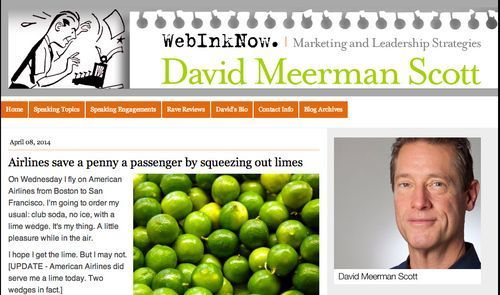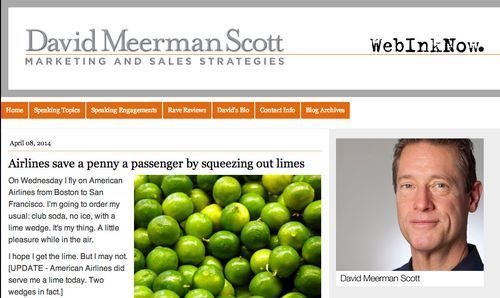David Meerman Scott's Blog, page 66
April 10, 2014
Personal brand or corporate brand
Twelve years ago, I left the corporate world to go independent and live by my wits. And ten years ago I started writing my blog.
I made two decisions at the time I wish I hadn’t. I branded myself as a business called Freshspot Marketing and I named my blog Web Ink Now.
Rather than using my name David Meerman Scott, I branded other things. These were errors because the names Freshspot Marketing and Web Ink Now didn’t mean much and have been confusing.
Fortunately, the web is iterative and you make changes over time.
New blog masthead
Yesterday I rolled out a new blog masthead to focus on my name David Meerman Scott rather than the blog name Web Ink Now. I also started using “Marketing and Sales Strategies” instead of “Marketing and Leadership Strategies” because sales better describes what I talk about on my blog and in my books and speeches. You can see before and after below.
I worked with my long time designer Doug Eymer on this. We also changed the header to the email updates to my blog distributed through FeedBlitz. If you subscribe via FeedBlitz you’ve already seen this change. (If you would like my blog updates via email, you can sign up on the FeedBlitz form at the right of my blog below my photo.)
Your personal brand
If you are selling your services, you should figure out if you want to brand your own name so people know you for your expertise or if you want to brand a company name instead. I wrote about this important distinction last year in a post called A company or a guru?
I started with the wrong approach and it has taken me a decade to figure that out and unwind parts of it.
No right or wrong answer
Independents have a fundamental choice: Should you brand your name or a company name? Either approach can succeed. However, people who don’t make the choice are positioning themselves somewhere in the middle and that can pose branding problems.
My blog before
My blog now
April 8, 2014
Airlines save a penny a passenger by squeezing out limes
 On Wednesday I fly on American Airlines from Boston to San Francisco. I’m going to order my usual: club soda, no ice, with a lime wedge. It's my thing. A little pleasure while in the air.
On Wednesday I fly on American Airlines from Boston to San Francisco. I’m going to order my usual: club soda, no ice, with a lime wedge. It's my thing. A little pleasure while in the air.
I hope I get the lime. But I may not.
It seems some airlines including Alaska Airlines and United Airlines are choosing not to include a lime with drinks because of a price increase.
How much you ask?
I calculate the lime wedge in my drink went from two cents to three cents. That added single penny means some airline bean counters are saying no to tartness.
This is a silly response to a price increase. Businesses need to think of customers first and saving pennies second.
Mexico’s limes
After heavy rains, tree disease, and cartel violence sent prices of Mexico’s limes from $14 a case to $100, some businesses including restaurants, bars, and airlines have chosen to forgo the fruit.
This morning I read an Associated Press report: A spike in lime prices has led some airlines to eliminate the fruit from their drink service. The AP story quoted Alaska Airlines spokeswoman Halley Knigge who said the airline normally goes through about 900 limes a day.
The average advertised price of a lime in U.S. supermarkets was 56 cents last week, according to the U.S. Department of Agriculture via AP. That's up from 37 cents the week ending March 28 and 31 cents a year ago.
Fifty-six cents a lime in a supermarket means what, thirty cents wholesale? How many drink wedges are in one lime? Maybe ten? We’re talking an increase of a penny per drink!
Who do you work for?
Are you running your business on a penny saved per person?
Or are you running your business by keeping your customers happy?
Photo: Limes in a grocery store, Austin, Texas USA December 16, 2006 by Steve Hopson via Wikimedia Commons.
April 2, 2014
More top ten tips for incredibly successful public speaking
Back in 2009, I wrote what became one of my most popular blog posts. In Top ten tips for incredibly successful public speaking, I riffed about making the most of your opportunity to deliver a talk. Here are the top ten tips from 2009. You can go back to read the original post to get more detail on each.
1. Take it seriously.
2. Know the conference organizer's goals.
3. Tell stories.
4. Nobody cares about your products (except you).
5. Prepare and practice.
6. Don't use PowerPoint as a TelePrompTer.
7. Arrive early.
8. Bring an electronic copy of your presentation.
9. Don't go long.
10. Be aware of body language.
Since that 2009 blog post, I’ve delivered hundreds of live presentations. In reviewing the list I realize I have more tips to add. So here are more thoughts on how you can deliver a great talk.
More top ten tips for incredibly successful public speaking
11. Learn from the best. You should always look to improve your speaking skills. I’m still learning from the best. At conferences around the world, I watch other speakers and see if I can find something new to add to my talks. Recently I’ve enjoyed watching people speaking in languages other than English because I can focus on how they use non-verbal language since I don’t understand the words.
Two recent books I’ve found very helpful are Power Cues: The Subtle Science of Leading Groups, Persuading Others, and Maximizing Your Personal Impact by my friend and speaker coach Nick Morgan. The book will be out later this month, but I got an early copy and offered this cover quote to Nick: “The profound wisdom in Power Cues has transformed my life . . . For those who want to reach the top of their fields through truly effective communication, what you will learn here works brilliantly.” I also recommend Talk Like TED: The 9 Public-Speaking Secrets of the World's Top Minds by Carmine Gallo. In analyzing why the best TED talks are highly addictive, Carmine offers wisdom to all speakers.
12. Find out about the audience. You should have a conversation with the conference organizer several weeks prior to the event. Find out who will be in the audience. What is their level of understanding of your topic? What takeaways would the people running the conference like you to leave with the audience?
13. Test the technology! Prior to going on, you must get onto the stage and check out the equipment. I try to do that the evening before I speak so that I can go to sleep knowing all is well (or solve any problems well before the event). If you are using a computer you should fire it up and run through the material. Test the microphone. Ask to have the lighting set to what it will be when you talk. You want to be comfortable on the stage so there are no surprises.
14. Prepare for things to go wrong. Part of your technology check is planning for things that might go wrong. For example, I always have a backup of my presentation on another computer in the room. In case of a problem, I can switch right away. I learned this the hard way when I spilled water on my computer and fried it while presenting at an engagement at the European Union offices in Brussels.
15. Help the MC to find an interesting way to introduce you. Most introductions are a dry reciting of your qualifications. You should offer the person who will introduce you with interesting fodder that is not already found in your bio.
 16. Have fun! The audience can sense your state of mind. Are you nervous? Arrogant? Tired? These all come through, more than you might think. I’ve found that when the audience sees a speaker having fun on stage, they have fun too. So don’t take yourself too seriously! Enjoy the moment and let your enjoyment shine through.
16. Have fun! The audience can sense your state of mind. Are you nervous? Arrogant? Tired? These all come through, more than you might think. I’ve found that when the audience sees a speaker having fun on stage, they have fun too. So don’t take yourself too seriously! Enjoy the moment and let your enjoyment shine through.
17. Work the entire stage. Many speakers stand behind a podium. Or if they venture out a little, they go back and forth in a small section of the stage like a metronome. Try to move to all areas of the stage.
18. Include real-time elements. Check the news a few hours before your talk and try to build a current example into your remarks. People love when a speaker has a timely comment on what’s just gone down in the industry. At most conferences, there is a backchannel discussion on social networks. So as soon as you can after your talk, check the Twitter hashtag, your Twitter mentions and any other social media that people might have used. Reply back to people, post additional content, and keep the discussion going.
19. Get photos and videos of the event from the organizers. If there was a video shot of the event, see if you can get a copy to post to YouTube. If there was an event photographer, find out if you can have access to the photos. Having video and photos of your talk is useful to share with people who might want to invite you to speak at a future event. The photos here were from my keynote at Be-Wizard in Rimini Italy on March 21, 2014.
20. Ask for honest feedback. Use the talk as a learning experience. What can you do better next time?
March 28, 2014
This Is a Generic Brand Video
Rick sent me awesomeness This Is a Generic Brand Video.
Considering it has 602,000 views in just a week, perhaps you’ve seen it. But it was new to me.
Humor is truth
The reason I think this is hysterical is because it is so spot on. The ridiculous nature of stock photos and stock video is something that all marketers can relate to. Yet many of us still keep using this stuff.
I first wrote about visual gobbledygook in a 2009 Who the hell are these people? It remains one of my most popular posts.
Poking fun
The company behind this video - Dissolve - provides footage on a wide variety of topics for use in television, web, and corporate videos. How cool that they are promoting their business by poking fun at it. And they are getting tons of attention as a result.
March 20, 2014
Making healthcare personal
Recently, I wrote a post about Dr. Kate Burke, an emergency physician who uses video in her practice, shooting clips for patients at the end of an emergency room visit explaining the treatment and what to do upon getting home.
That post about the great work Kate is doing to educate patients and their families was prompted by my personal experience with terrible healthcare customer service.
Today I’m introducing another clinician doing fantastic customer service, this time via her blog, Facebook, and Twitter.
 Natasha Burgert, M.D. —- a full-time primary care pediatrician at Pediatric Associates in the Kansas City area who has a passion for educating families in unique ways through her blog and in social networks —- also noticed that the parents of her patients weren’t retaining the information she shared on visits. “The clinic space is not a good learning space,” she says. “It’s an information gathering space but it’s not a learning space.”
Natasha Burgert, M.D. —- a full-time primary care pediatrician at Pediatric Associates in the Kansas City area who has a passion for educating families in unique ways through her blog and in social networks —- also noticed that the parents of her patients weren’t retaining the information she shared on visits. “The clinic space is not a good learning space,” she says. “It’s an information gathering space but it’s not a learning space.”
Dr. Burgert uses her @doctornatasha Twitter feed, her Facebook page, and her KC Kids Doc blog to share information with parents, the teenagers she serves, and the community at large. Like Dr. Burke, she sees tremendous value in delivering follow-up information via social tools.
“If you really want to know why your kid gets a fever, what you need to do about it, what’s good, what’s bad, what are the myths and what are the facts, that’s a long discussion and quite frankly you are going to understand about 10% to 20% of what I say,” Dr. Burgert says. “So I deliberately don’t answer those questions in a visit and I say here’s three blog posts that I wrote that are going to explain all that you want to know. When your kid gets a fever then go back to it and look again, that’s the time that you are going to learn. I specifically won’t answer certain questions that I have written about because I just don’t think that’s time well spent. It’s in one ear and out the other especially when you are distracted by your kids in the office. You are worried about they are getting shots that day. Maybe they’re not feeling well.”
Dr. Burgert’s KC Kids Doc blog allows her to deliver important health information but with her personal spin and in real-time. Because she’s seeing patients every day, the content is derived from her experience in the office. “In the big machine of the Academy of Pediatrics and WebMD and these wonderful places that you can go for health information, sometimes they just don’t turn over quickly enough in order to be practically useful so that’s where the blog started,” she says. “The blogging is to specifically respond to things that I was seeing in my day to day practice life that were important to families who wanted my opinion and needed some direction, but weren’t necessarily some of the things that large health information sites were able to provide.”
For example, in discussions with teenage girls she was seeing, Burgert started to hear a few talking about “thigh gap.” So she asked the teenagers a bunch of questions and learned that girls were trying to achieve a valued “gap” between their thighs when standing with their ankles touching. For those girls without a gap, they shared diet tips and exercise routines to create one. Burgert was horrified. She did some research and noticed there was very little written using the phrase “thigh gap.” She realized she was seeing an early trend and quickly wrote a post Thigh Gap: The Newer and Disturbing Trend in Body Awareness to get the word out to girls and their parents that this is not a healthy choice. The post provides tips for parents to talk to their children about healthy body image and details signs of an early eating disorder.
“My blog, Facebook, and Twitter are a bit of real life,” Burgert says. “It’s my opinion although I try to support my comments with as much evidence based literature as I can. I think that is the beauty of having a place where you can speak your mind as a physician. We have these amazing conversations with families that I think are really, really valuable that need to be shared, especially with my teenagers. They are very open with me and honest about the concerns and issues that they have. Hopefully I can prevent other kids having troubles with that if I didn’t have that platform I couldn’t share it as widely as I do. Parents enjoy the fact that they can turn to one place that is going to have a conglomerate of both the research evidence in my opinion.”
Dr. Burgert creates the content typically in her blog and then shares links via Facebook and Twitter. But she gets the information to parents in any way they are comfortable. “Our community is very technologically savvy so many people will just look it up,” she says. “But my job is to offer as many ways to get to your hands on the information as possible. I will just text you the link or email you the link. I have bit.ly short codes for all of them. I can write them down. And I have QR codes that I pop onto my computer screen where I am doing my Electronic Medical Record, so they can just scan on screen with a QR reader. For those who don’t want all that electronic stuff, I have paper copies. It is my patient’s choice how they get that information.”
As Dr. Burgert was explaining all this to me, I was struck at the contrast between how she and Dr. Burke get information to patients compared to my physical therapist and the stick figure cartoon he sent me. In addition to providing information to patients and parents after a visit, she also anticipates what people will need prior to a visit.
“If I know that you are going to come in to me for this specific issue, I can guess what your questions will be,” she says. “I can preempt that visit by giving you answers to those questions and when we come together and we’re going to talk about how those answers are specifically relevant to your family and not general just information that you can get anywhere. I develop a plan and specifically ask those questions about what might be unique to your family. It’s important education piece to get some right framework but it’s not plan forming.”
Beyond the value her blog and social presence provides to individual patients and her families, Burgert says there is a sales aspect to what she is doing as well. “It’s beyond information distribution,” she says. “It’s actually a relationship building tool and a valued place for families who are trying to make the best decisions for their kids.”
She’s seen lots of evidence that her blog posts are shared via social media and are discussed by parents in the community, raising awareness of her practice. “That’s how my brand is marketed and that’s how people get into the clinic, bringing their families because they heard about us on the soccer field,” she says. “I can watch the tracking of how it’s being shared through Facebook and where it’s getting linked out from the blog.”
While the agile service she provides to families and the community serve to bring in new patients, she sees a much bigger role for her efforts. “A lot of people ask why I started doing it but I think the bigger maybe and more important answer is why I keep doing it,” she says. “Medicine is changing and how patients are making health decision are changing. As a pediatrician who went to school for a long time, I want to be able to use my knowledge and use my training effectively. There are new ways to distribute the knowledge that we have so I keep doing it because it provides such great value within the community and that’s an amazing feeling as a physician to think that you are improving on what’s already an amazing career by trying something new. Parents come in and say, ‘you know I was really, really worried about this. It was causing me to lose sleep and I could turn to your Facebook page and I got a lot of reassurance and calm and I could rest well.’ I often hear the comment there’s just so much information out there, but parents just want to know what I think. They have already chose me as their pediatrician, they trust me, now they just want to know what I think so they don’t have to worry about doing all of this research and investigation themselves.”
As Dr. Burke and Dr. Burgert show, it is possible to deliver excellent customer service in healthcare. I look forward to the day when the kinds of things they are doing to make patients healthy and their families informed are the norm.
Photo of Dr. Natasha Burgert courtesy of Pediatric Associates.
March 17, 2014
Being a freak and making art
In 2002 I left a nice, safe corporate career to find my art, to discover my true self, and to live life as a freak.
It was scary. I didn't know where the journey would lead. I had no clue if I could make a living by my own wits.
People said I was crazy. They argued I was throwing my career away. They told me there’s no money in writing books. They said you can’t make it on speaking circuit unless you’re famous. My parents told me they were very worried.
I didn’t follow any of their advice.
Instead, I focused on art and my own freaky views of the world and so far I’ve managed to thrive for more than a decade without a corporate paycheck.
Art, not business
So what do I mean by making art and being a freak? I’ll let three of my favorite writers and my favorite painter help me with that question. I admire these four people and their work has helped me over the years to be comfortable doing my own art.
Bob Lefsetz writes about the music business, but his work is applicable to anyone. In a terrific post last month titled Art, Not Business, Bob says the following: “A businessman plays by the rules, an artist breaks them. A businessman puts money first, an artist sees money as a byproduct. A businessman has a plan, an artist flies by the seat of his pants.” There’s a lot more. Read the post.
Seth Godin writes a lot about these themes, but the most comprehensive is in his book The Icarus Deception: How High Will You Fly? It is an ambitious work that challenges you. It's for anyone who is living life as a cog in the machine and who dreams of breaking free, making art, and creating something meaningful. Seth says: "Being an artist isn’t a genetic disposition or a specific talent. It’s an attitude we can all adopt. It’s a hunger to seize new ground, make connections, and work without a map. If you do those things you’re an artist, no matter what it says on your business card."
Chris Brogan has a brand new book The Freaks Shall Inherit the Earth: Entrepreneurship for Weirdos, Misfits, and World Dominators that releases later this month. I received a pre-publication copy and I’ve enjoyed the book immensely. I wish I had it when I started my business. The premise of Chris’ book is simple: “How can I do business my way and be successful, when the way I think and the goals I have aren’t in line with conventional thinking?” There’s a career path for freaks and Chris shows how.
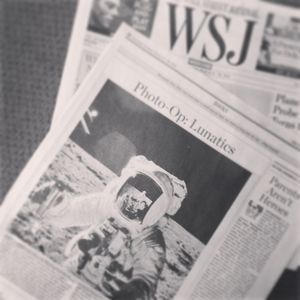 Alan Bean, the 4th human to walk on the surface of the moon, left NASA in 1981 to devote the rest of his life to (literally) making art and he’s still painting today at age 82. Alan says: "I was fortunate to be the first artist with the opportunity to be in the center of the action to capture what I saw and felt, and bring it back to earth to share with generations to come. It is my dream that on the wings of my paintbrush many people will see what I saw and feel what I felt, walking on another world some 240,000 miles from my studio here on planet earth."
Alan Bean, the 4th human to walk on the surface of the moon, left NASA in 1981 to devote the rest of his life to (literally) making art and he’s still painting today at age 82. Alan says: "I was fortunate to be the first artist with the opportunity to be in the center of the action to capture what I saw and felt, and bring it back to earth to share with generations to come. It is my dream that on the wings of my paintbrush many people will see what I saw and feel what I felt, walking on another world some 240,000 miles from my studio here on planet earth."
I commissioned Alan's painting Boy, you can sure move on this surface and my wife Yukari and I have become friends with Alan.
In the most recent Weekend Edition of The Wall Street Journal, my new book Marketing the Moon (which I co-wrote with Rich Jurek) is featured in the book section. And in a wonderfully freaky cosmic twist, the large photo selected by WSJ from the 300+ photos in our book is of Alan Bean on the lunar surface.
Your art
For me, creating art meant starting something new. The same was true for Alan Bean.
But you can create art within an existing structure too.
It's doctors like Kate Burke, M.D. who choose to communicate with patients through video even though the medical establishment looks down on such personal care.
It's the customer service rep who brings his colleagues together every Friday afternoon to figure out ways to do their jobs better.
It's anyone who picks herself to do something important rather than waiting for an authority figure to give authorization to proceed.
My art
I’ve enjoyed being a freak and doing things my way. Marketing the Moon - published by MIT Press - is a good example. Some people think of me as an expert in social media marketing. While I would never describe myself that way, it is true that my recent books have talked about ways to reach buyers using real-time content and social media.
 The safe move for me would be to write another book about modern marketing.
The safe move for me would be to write another book about modern marketing.
So it is a freaky move indeed for me to go in a completely different direction and write a fully-illustrated, large-format book on the Apollo space program. Marketing the Moon explores the greatest marketing case study in history. It looks back to an era before Mark Zuckerberg and Jack Dorsey were even born.
But it’s my art.
I flunked Introductory calculus in college and never took another math course in my life. Yet MIT Press, the book arm of arguably the most prestigious math and science university in the world, published my book. Very freaky.
I left the corporate world behind, yet the Wall Street Journal, the go to publication for corporate America, published a half page about my art. Even more freaky.
Without art, MIT would reject me. Without art, the Wall Street Journal wouldn’t care.
Take it from me (and Seth and Bob and Chris and Alan): If you make art and embrace your inner freak you can do most anything!
What will you do?
March 12, 2014
It’s not about how you sell. It’s about how I buy.
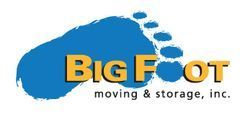 Today buyers are in charge. The idea of mystery in the sales process is over.
Today buyers are in charge. The idea of mystery in the sales process is over.
We research someone online before agreeing to a first date—is he a creep? We fire up LinkedIn an hour before an initial business meeting—does she have anyone I know in her network? We watch an on-demand movie trailer before deciding which film to see that night at the theater. We check out restaurant reviews and browse menus before making a booking.
We’re in a new world. But you know that because you’re living the new world every day.
I am in the process of moving the little office I work from in the Boston suburbs. It is a very simple move from the first floor to the second within the same building.
I researched moving companies in my area by doing a Google search that led me to visit their web sites. I also checked out review sites like Yelp. Within five minutes, I narrowed my search down from dozens of moving companies to three. To each of these three, and at about the same time, I sent an email through their “contact us” page which included my requirements, the dates and times I’d like to do the move, and photos of my current office so they could see the things I needed to be hauled upstairs.
One company reached me within about two hours, providing detailed information and a tentative price quote based on my email to them. Another company had its representative phone me about six hours after I sent my email and leave a voicemail asking me to call back. The third company, the one with the cheapest price, got back to me by email with a quote the next day.
Granted, my job is tiny for these moving companies. I’ll pay less than five hundred dollars for half a day’s work.
Guess who won my business?
It wasn’t the cheapest company. It wasn’t the one who left a voicemail asking me to call back. I chose to go with Big Foot Moving & Storage because they got back to me quickly and had detailed information based on what I provided. They didn't waste my time with back and forth nonsense.
It’s not about how you sell. It’s about how I buy.
I chose Big Foot because the story I told myself went something like this: “I don’t like waiting for service people to arrive. I want to have people do what they promise and I don’t mind paying a little extra to get better service.”
The company that got back to me the quickest won my business because in my mind, that was the company that was most likely to show up to my office on time and do the work as agreed.
Are the stories that buyers tell themselves in line with how you sell?
The move happens in a few weeks. I'll report back if there are any dramas.
March 6, 2014
Healthier patients through video customer service in healthcare
Several weeks ago, I wrote a blog post titled Terrible healthcare customer service. It was a rant based on my experience as a patient and as a family member of patients where I argued that the healthcare industry has the absolute worst customer service there is. That’s the bad news.
The good news is I’ve met clinicians who are doing fantastic customer service and today I introduce you to one.
According to a report by the Center for Information Therapy, patients remember only half the information conveyed to them just five minutes after a healthcare consultation. This disconnect between doctors and patients means a huge customer service problem in healthcare.
 “Clinicians assume patients understand the terminology we are using with them about their diagnosis and the plans for treatment and clinicians are assuming their understanding and cognition can occur very rapidly. These are two very incorrect assumptions,” says Kate Burke, M.D., an emergency physician at Milford Regional Medical Center in Massachusetts who also serves as president of Orion Emergency Services, her group practice employing 22 physicians, and as Clinical Associate Professor, University of Massachusetts Medical School. “Patients are not in our heads as we are rifling through our differential diagnoses of what’s wrong with this patient, nor do they have the training, background, or vocabulary that we spent a long time learning. Is it not acceptable to think they can remember things as quickly as we frequently speak. This leads to a real communication gap between what the clinician believes they have communicated clearly with the patient and what a patient understands about what the clinician was trying to communicate.”
“Clinicians assume patients understand the terminology we are using with them about their diagnosis and the plans for treatment and clinicians are assuming their understanding and cognition can occur very rapidly. These are two very incorrect assumptions,” says Kate Burke, M.D., an emergency physician at Milford Regional Medical Center in Massachusetts who also serves as president of Orion Emergency Services, her group practice employing 22 physicians, and as Clinical Associate Professor, University of Massachusetts Medical School. “Patients are not in our heads as we are rifling through our differential diagnoses of what’s wrong with this patient, nor do they have the training, background, or vocabulary that we spent a long time learning. Is it not acceptable to think they can remember things as quickly as we frequently speak. This leads to a real communication gap between what the clinician believes they have communicated clearly with the patient and what a patient understands about what the clinician was trying to communicate.”
Dr. Burke became interested in this disconnect through personal experience with an orthopedic injury she suffered while skiing. She struggled to recall exactly how to do her physical therapy exercises at home. Then she had an idea: On the next visit to her therapist, she took her video camera, asking him to record her correctly performing her exercises in his office so she could remember exactly how to do each movement at home.
“It was a real 'a-ha' moment for me as a doctor,” Kate says. “I thought ‘Wow, this is unbelievable. I can play my own rerun to revisit my physical therapy sessions and store them on my computer. I can have all of the content that was shared with me from three and four years ago to use regularly and routinely, not requiring me to go back to the provider.”
Since that experience as a patient, Kate has implemented video in her own practice, shooting several minute clips for patients at the end of an emergency room visit explaining the treatment and what to do upon getting home. And she’s become involved with The Center for Information Therapy, whose sole focus as a not-for-profit organization in Washington DC is working to closing the gap of patients only remembering 50 percent of what a clinician was trying to communicate. “This led me to trying to figure out a way to share HIPPA compliant videos with patients in a more scalable fashion,” Kate says. “Video shot during a healthcare consultation can help patients recall important information and instructions later. It is a game changer and will become the standard for ongoing physical care and in other areas of healthcare, too.”
HIPPA is a U.S. government act protecting the privacy of individually identifiable health information and which sets national standards for the security of electronic protected health information.
The disconnect between what doctors say in a visit with a patient and what patients recalls is a hidden problem because doctors are expected to communicate well and patients are afraid to speak up when they don’t understand. Together, these issues lead to a terrible customer service problem in the way healthcare is delivered.
Excellent communications
“We are talking about communication, basic skills that everybody assumes any clinician who goes into healthcare—whether you are a doctor or therapist or nurse—has as routine,” says Kate. “But communication skills are not necessarily inherent in every individual in medicine. But this is a skill that can be amplified and taught, and clearly now with the ability to capture that critical piece of information in the simplest of manners, by using technology at our fingertips, our smartphones.”
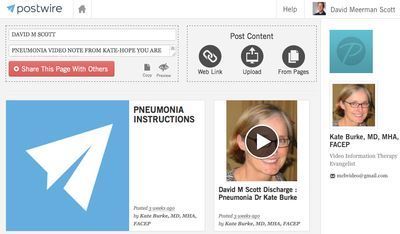 Dr. Burke films several minutes of her discussing the patient’s condition and treatment near the end of the emergency room visit. Depending on the situation, she might film the patient or a member of the patient’s family such as when family members need to learn how to safely lift someone who needs help moving. Or she might film herself talking directly to the camera when detailing after care aspects of treatment such as how to take medicine and what foods to avoid. She then shares the information via Postwire Health, a web-based, HIPAA-compliant patient engagement tool used to create a private, customer-friendly place for each patient. She may share articles and links to other content on the Postwire private page too.
Dr. Burke films several minutes of her discussing the patient’s condition and treatment near the end of the emergency room visit. Depending on the situation, she might film the patient or a member of the patient’s family such as when family members need to learn how to safely lift someone who needs help moving. Or she might film herself talking directly to the camera when detailing after care aspects of treatment such as how to take medicine and what foods to avoid. She then shares the information via Postwire Health, a web-based, HIPAA-compliant patient engagement tool used to create a private, customer-friendly place for each patient. She may share articles and links to other content on the Postwire private page too.
“We all have iPhones or Androids so clinicians have the ability to capture and share information that’s critical and curated to a particular patient,” Kate says. Patients already have the tools required to view the content, simply by firing up their computer or tablet. “It can be shared literally within seconds and integrated into a clinical encounter. I shared my passion with many different clinicians of every flavor and type that you can imagine that you would find it a community hospital and through my work at the medical school. Now I am teaching a fourth-year elective, Best Practices in Communication, and have integrated this into the curriculum. When I discuss this with students, their response is ‘Yeah, of course we would do that.’ I have seen an amazing growing acceptance.”
Dr. Burke describes the problems faced by those who receive a cancer diagnosis. It is a very difficult time for patients and their families while they come to grips with the nature of their disease. Many do a great deal of research on their own. “There are many confusing opportunities for patients relative to cancer care,” she says. “Patients have all these questions and learn how important it is to get different opinions. But how, as a patient, can you keep track of this? How can you remember those nuanced suggestions by these incredible experts that are trying to fit all this information into the visit? A clinician can help by curating the content. They can help direct each patient to really good sources that are germane to them.”
A major additional benefit to providing video based after care information and links to external content on a personal site is patients can share with their family members. “This is very powerful way to take care of a human being,” Kate says. “This creates some wonderful equalization so we can all share. There can be transparency. We can stamp out any confusion or misunderstandings very early in the doctor-patient relationship.”
The tools required to do this sort of information sharing and thereby significantly increase patient satisfaction are simple to implement and use. All that’s needed are a smartphone camera and a secure online place to store information.
Real-time engagement for any business
You don’t need to be a physician to use the benefit of this approach because content curation for individual customers and video customer service can work in any business. In your business, just substitute the word “customer” for “patient” in this example.
People are naturally reluctant to change the way they work with customers and doctors dealing with patients are no different. A radical change in how we communicate is not difficult. All that’s required is eliminating fear of the unknown and learning a new routine. Sure the first few weeks might involve a learning curve. But after that, there should be no additional effort to required to communicate with customers in a way they will appreciate.
“The evolution in medicine using technology and digitized information is happening at an exponential fashion,” Kate says. “Several years ago there were many clinicians who could not imagine using an electronic medical record but that is current routine now. It is incumbent upon physicians to improve this egregious situation of how we communicate with patients, the information we want them to carry forth in their recovery process, and sharing with their families. Once you admit you have a problem with communication and patients remembering what we are communicating, then you can move on to the solutions. One wonderful way to do it is to leverage technology, which is in their hands practically every minute of the day. For me, this is incredibly exciting. It brings tears to my eyes that this is happening because finally we are going to address the problem of understanding on the patients’ side.”
Photo: Milford Regional Medical Center
Disclosures: I am an advisor to Postwire and Kate is a friend.
March 5, 2014
California trial lawyer comments on legal aspects of news to grow influence
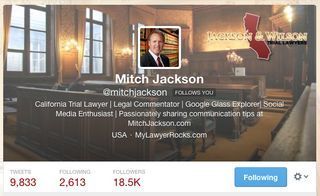 Mitch Jackson is a senior partner in the California law firm Jackson & Wilson with the fantastic pointer URL MyLawyerRocks.com.
Mitch Jackson is a senior partner in the California law firm Jackson & Wilson with the fantastic pointer URL MyLawyerRocks.com.
Jackson & Wilson are an established firm, with local lawyers, judges, and past clients frequently referring cases to them.
Even though they have plenty of business, Mitch writes a blog where he comments on the legal aspects of stories in the news and shares via social networks. And he gets tons of attention as a result. His popularity has resulted in more than 18,000 followers of his @MitchJackson Twitter feed.
For example his post Michael Sam is Gay and the NFL Team That Drafts Him Will Face Major Litigation Exposure resulted just a few hours later in being invited to appear on a Fox Sports show with @Seth_Everett to talk about the NFL and Michael Sam.
Building a terrific personal brand
Did I mention Mitch is a lawyer? Many people tell me that the ideas I discuss like real-time marketing and newsjacking aren't for them. They say their business is different.
Mitch’s post Who Is Responsible for the Death of Philip Seymour Hoffman? was written soon after the death was reported and gave people a different way of looking at the sad story.
“Several of my recent posts have increased views by 500-1000%,” Mitch says. “The Philip Seymour Hoffman post generated a nice level of dialog and comments on Facebook, Twitter and the blog. All links with modified teaser captions were shared on my social platforms such as Twitter, Facebook, Linkedin, Instagram, Vine, Pinterest and Google Plus.”
As I write this, Mitch is commenting in real-time on the Oscar Pistorius and Reeva Steenkamp murder trial happening now in South Africa. A few other recent stories include:
What Will Happen Next in the Amanda Knox Murder Case?
Justin Bieber Arrested for DUI
“My goal is to continue enjoying an expanded sphere of influence through sharing my expertise on social media as opposed to needing to get the phone to ring,” Mitch says. "Although the phone does ring with these efforts, that's not really the focus. And this is also a nice and enjoyable way to break up the day.”
Mitch tells me his personal favorite was the Rebecca Sedwick bulling case last October. “It gave me a chance to share tips and tools to families experiencing bullying and offer legal solutions,” he says. How This California Law Firm Handles Bullying Cases
Thanks for sharing with us Mitch. Keep up the great work.
March 3, 2014
Real Time at the Oscars
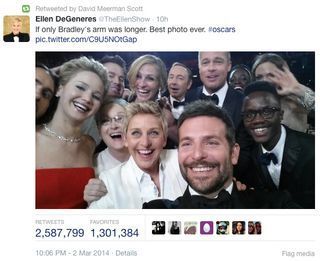 It was fun to see Ellen DeGeneres do a selfie as she hosted the Academy Awards telecast. It injected some fun, real-time quirkiness to what is an over-produced event.
It was fun to see Ellen DeGeneres do a selfie as she hosted the Academy Awards telecast. It injected some fun, real-time quirkiness to what is an over-produced event.
The photo brought Twitter’s servers down for about 20 minutes and by the end of the Oscars broadcast had become the most retweeted tweet ever.
In the photo, the actors aren’t posed like you usually see them. And it’s not a paparazzi shot. It’s just people worming their way into a photo just like we’ve all done. It adds a great deal of humanity to people who seem super-human. Front row from left, Jared Leto, Jennifer Lawrence, Meryl Streep, Ellen DeGeneres, Bradley Cooper, Peter Nyong’o Jr., and second row, from left, Channing Tatum, Julia Roberts, Kevin Spacey, Brad Pitt, Lupita Nyong'o and Angelina Jolie.
Real-time in your business
Real-time is now a part of every business. Live broadcasts like the Academy Awards and the Super Bowl bring people together. But it’s no longer a passive one way watching of television. Instead we share or thoughts via social networks.
Speeches, corporate events, and conferences include a real-time back channel where people discuss what's happening on stage. Presenters can participate too.
We react instantly to the news. If you have a take on what’s going down, you can showcase your expertise at the precise moment the world is looking for it. Newsjacking is the art of injecting your ideas into a breaking news story.
For salespeople, real-time is critical. Today buyers are in charge. The idea of mystery in the sales process is over. We research someone online before agreeing to a first date—is he a creep? We fire up LinkedIn an hour before an initial business meeting—does she have anyone I know in her network? We watch an on-demand movie trailer before deciding which film to see that night at the theater. We check out restaurant reviews and browse menus before making a booking.
We’re in a new world. It’s real-time. But you know that. Not because I say it a lot but because you’re living the new world every day.

